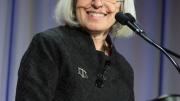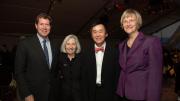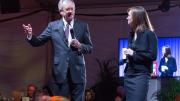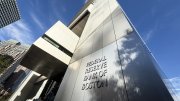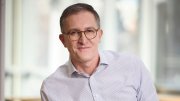At a time of substantial change in legal education and the profession—in which the careers of law-school graduates develop in increasingly varied, often global, professional contexts—Harvard Law School (HLS) kicked off its “Campaign for the Third Century” on Friday, October 23, with an afternoon of speeches and panel discussions that hinted at some of these transformations in practice and pedagogy. Later, during a gala evening dinner featuring speeches by Harvard president Drew Faust and HLS dean Martha Minow, campaign co-chair James A. Attwood Jr., J.D.-M.B.A. ’84, announced a campaign goal of $305 million, of which he said $241 million (79 percent) had already been raised in “the silent phase.” Minow announced a campaign-leading $15-million gift from Michael R. Klein, LL.M. ’67; the school will soon add his name to what is now the Berkman Center for Internet and Society. (There were also appearances by CNN analyst and New Yorker staff writer Jeffrey Toobin ’82, J.D. ’86, as master of ceremonies; The Paper Chase’s author, John Jay Osborn Jr. ’67, J.D. ’70, formerly a professor of law at the University of San Francisco, who said that “HLS is in the DNA of law schools across the country”—literally, the “mother of all law schools”; and his daughter, Meredith Osborn ’02, J.D. ’06, who compared her student experience to her father’s, concluding that HLS remains a “challenging” place, but not the fearsome one depicted in his novel).
Reframing the Profession in a Global World
Campaign priorities include financial aid and clinical education, both deemed critical to the school’s mission of advancing justice, increasingly among the underserved. Since becoming dean in 2009, Minow said in an interview before the campaign launch, she has nearly tripled spending on financial aid (Harvard and Yale are the national leaders in extending need-blind admissions not only to J.D. students, but to all LL.M. students, says Stimson professor of law William P. Alford) and loan forgiveness (for J.D. students who enter nonprofit careers after graduation). “We want any student who is qualified to do the work here to be able to come to Harvard Law School, afford the education, and be able to pursue any career that they want,” she asserted, “and so we carry that as a cost. We don’t have a cap on it, and it is central to our mission.” Likewise, clinical education, in which students receive hands-on experience in the law, often by working with low-income clients, has become increasingly important in the curriculum. But such pedagogy is costly, she pointed out, simply because of its low student-to-faculty ratios as compared to lecture classes.
The school’s commitment to such teaching is longstanding, however. Its previous campaign, which aimed to raise $400 million (and exceeded that goal handily by its 2008 conclusion) helped to build Wasserstein Hall, a structure the size of Yale Law School that houses in one wing the physical space dedicated to clinical education.
“Harvard is in the vanguard of experiential learning,” says clinical professor of law Daniel Nagin, vice dean for experiential and clinical education and faculty director of the Legal Services Center and its veterans legal clinic. Social-science research in higher education generally, and even in legal education, he says, shows that students learn more when practicing skills. And students want these experiences. “The clinics and the student-practice organizations, which are non-credit-granting but provide experiential learning, are enormously popular,” he reports. “Students are very much focused on these kinds of opportunities to lawyer and to advocate by working on real-world problems” while in school. By the time they graduate, 75 percent to 80 percent of the student body will have participated in a clinic, and an even larger group will have participated in some kind of experiential learning. Students, says Nagin, “are voting with their feet.”
Minow likened the role of the school’s 29 clinics to that of “teaching hospitals” at medical schools. In addition, HLS has 11 student-run, non-credit, practice organizations, such as the Prison Legal Assistance Project; every HLS student is exposed to practice while learning through such pro-bono service. This integration of hands-on learning into the curriculum is “probably the biggest change in legal education in the last 30 years,” she said, and the public-service component is critical. “Law is the armature of society, and a public-facing obligation: if you are an officer of a court, if you are the navigator who helps ordinary people understand the legal system, if you are representing a corporation, it is to actually help the values of the society be implemented. We take public service very seriously.” (Fifty hours of public service is mandatory for all students, but the average student performs more than 600 hours.)
Minow takes issue with the focus of some media reports alleging a crisis facing U.S. law schools generally. Large law firms have shrunk substantially since the recession began in 2008, she says, and even now are carrying only about two-thirds as many employees. Their hiring from recent graduating classes has been down since 2008 and lasting, systemic changes in the profession mean it may never fully recover. Corporations, demanding more accountability, are turning to in-house counsel to seek advice or oversee the outsourcing of specific kinds of work. The days when a corporate law firm could send an invoice with “just a number at the bottom” are over, said Minow, “and they should be.”
Nationally, she added, a substantial number of recent graduates are not finding work in law that requires them to have passed the bar. But she said the picture is more nuanced than this statistic suggests, because changes in the workforce have led to new kinds of work for people with legal training, even if that work doesn’t involve traditional legal practice. Minow chairs the steering committee of the Association of American Law Schools, enabling her to see the entire landscape of legal education in this country. “Many law schools are hurting and many law students are having trouble,” she acknowledged, even though HLS students, though not entirely unaffected, “are really not in that same position. Our students remain in great demand.” But there are changes in the profession, in what it means to be a lawyer and practice law.
Such change is the focus of the school’s Center on the Legal Profession, which conducts empirical research on lawyers who spend some or all of their careers outside practice, investigating why and what happens to them once they leave the profession. This shift has also raised the more fundamental question of what constitutes legal practice. A great deal of the current innovation in delivery of legal services is taking place as a result of the forces of globalization, so the center is working with scholars in countries such as Brazil, China, and India (emerging economies deeply entwined in the fabric of international commerce) as part of a multidisciplinary, multijurisdictional research collaborative—Globalization, Lawyers, and Emerging Economies (GLEE)—to investigate these changes. The work documenting “the rise of the profession” in these countries, says Alford, vice dean for the graduate program and for International Legal Studies, is “transforming assumptions we have had about the structure of law firms and, to some degree, what lawyers do.”
Ultimately, the lessons of this effort will help train students and practitioners for a changing legal landscape. “International and comparative perspectives are fundamental to what it is to be a lawyer in the twenty-first century,” Alford continues. For that reason, every first-year J.D. student must take a course about a legal system other than that of the United States. Alford says this immediate requirement makes a large impact in broadening student perspectives, because they “learn another way of thinking about law and legal institutions.” Examples include courses on the legal architecture of the international economic order or on a particular country. Alford himself teaches a course on China’s project of legal development. Enriching the dialogue at HLS, meanwhile, are students from more than 70 different countries. “I tend to think diversity of all kinds has much value. The type internationalization brings has benefits that sprinkle far beyond just the international itself,” he says: it broadens students’ ability to understand how others see the world, and “to envision what their hopes and problems are.” International perspectives also permeate faculty work, whether on issues of disability (Alford chairs a project that helps countries develop legal frameworks for ensuring the rights of persons with disabilities), on family law (including cross-border adoption), or on real-estate law (which 40 years ago, he says, one wouldn’t have thought would take on a global dimension).
These shifts in legal education, however, predate the global recession, and are not a response to it, Minow emphasized in her interview. In fact, she chaired the committee that brought these curricular changes to HLS in 2006 (see “A New Script for One L”), introducing into the first-year curriculum courses on legislation and regulation in the modern regulatory state; on international law; and on legal problem-solving, in which students confront “concrete, messy situations that aren’t pre-identified as a particular kind of problem (a contract issue, for example) and have to come up with alternatives” for dealing with it. If there is a crisis in legal education, she said, it is “not about how we get more jobs for lawyers in big firms,” but about “How do we actually improve justice in America? We are undergoing a period of great opportunity to redress the terrible defects of the criminal-justice system in this country. We don’t have too many lawyers representing poor people in the criminal-justice system—we don’t have enough lawyers. And we have to alter mandatory sentencing.” Given the fact that the United States has the highest rates of imprisonment of any state in history, she added, “We have to improve the judges’ alternatives to incarceration. We have to have improved alternatives to prosecution.”
Why is this the moment? “We have had a series of exposés of terrible misconduct by some police officers,” Minow continued. This has led to a national movement in which “people across the political spectrum see that, as a nation, [we need] to make improving the justice system a priority.”
Preparation for Life
“We prepare people to practice law, but we also equip people with analytic skills,” Minow reflected, “with knowledge about problem-solving, negotiation skills, understanding of institutions and how they work, understanding of systems and networks of power and how to navigate them, that turn out to be very helpful in business, in nonprofit and civic work, and almost indispensable if you want to go into elected office and write laws.” These skills also turn out to be “very germane for people who want to be writers and teachers. So among our graduates, the careers that people pursue vary over the course of a lifetime. It is not unusual for people to combine practicing law for some period with public service, with business, or with teaching. I think that what distinguishes them is they ask hard questions, they know how to get to the bottom of a problem, and they know how to be practical problem-solvers.”
Illustrating that point, Senator Mark Warner, J.D. ’80, of Virginia kicked off the campaign-day luncheon by saying, “I’ve never practiced a day of law.” A businessman (he founded Nextel) and later a politician, he outlined some of the big problems facing the country for an audience of HLS alumni, faculty members, and students. He spoke passionately about the national debt—and on the need to spend money now going to interest payments on that debt for education, infrastructure, and research instead. He also cited the need for “great legal thinkers” to solve present and future problems, such as the “complicated and inefficient U.S. tax code” and the problem facing successful millennials who have joined the workforce in vast numbers but don’t work in traditional jobs with benefits and safety nets. What, he asked, might happen to them in the next economic downturn?
After lunch, the assembly broke up to attend concurrent presentations on international human rights, corporate governance, the making of a civil-rights lawyer, and the veterans legal clinic (founded in 2012 with twin goals of pedagogy and service). These were followed by TED-type talks, 10 minutes or less each, by faculty members: Klein professor of law Randall Kennedy spoke about what the civil rights revolution from 1950 to 1970 has bequeathed the country; Berg professor of law Mark J. Roe discussed “short-termism” in corporations, driven by the stock market; Warren professor of American legal history Annette Gordon-Reed discussed black citizenship in the context of the events in Ferguson; Reilly clinical professor of law Susan Crawford discussed how cities are making themselves newly visible and accountable to citizens through data; and professor of law I. Glenn Cohen, faculty director of the Petrie-Flom Center for Health Law Policy, Biotechnology & Bioethics, discussed some of the ethical conundrums raised by the globalization of healthcare.
Later, at the gala dinner, President Faust touched on the school’s history, and its future, noting its self-evident impact in producing presidents, senators, Supreme Court justices, and CEOs. “We need the Law School and the extraordinary leaders it creates,” she said. “We need the clarity that it brings to confusing and divisive times. We need its capacity to civilize, and we need lawyers wise in their calling.”
Dean Minow reached into HLS history to underscore the school’s expanded vision of legal education. She pointed out that Oliver Wendell Holmes Jr., A.B. 1861, LL.B. ’66, LL.D. ’95, in his 1881 Harvard Law lectures, “emphasized that the life of law is not knowledge, but experience. And today, all J.D. students learn problem-solving skills.” Nineteenth-century dean Christopher Columbus Langdell “had a revolutionary idea that…there could be a national law school; don't just teach the law of Massachusetts.” Now, she said, “we have global reach.” Noting that the school’s “LL.M. students come from 66 countries and jurisdictions…from Andorra to Zimbabwe,” and that “16 percent of the current class of J.D. students are not from the United States,” she concluded: “We really are becoming the global school we always hoped to be.”
“We must prepare students to understand law and institutions anywhere and everywhere and to simultaneously think about…patent law in Japan and how would that affect my client in Massachusetts,” she continued. “The value of high-quality legal education, the need for legal order, have never been more apparent. The hunger for justice around the world has never been greater….We do and we must include the imperative of advancing justice in our core mission, in our reform efforts, and our preparation of students” so that they can “solve hard problems and imagine better worlds.”
